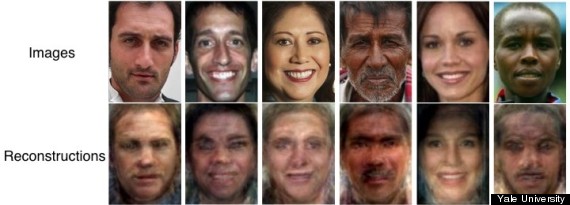The Huffington Post | By Jacqueline Howard
Facial images shown to men and women while they were undergoing fMRI scans (above), and the reconstructed images based off of that MRI data (below).
Scientists have now used brain scanners to hack into our thoughts like never before.
After scanning the brains of men and women who were looking at photos of different faces, researchers at Yale University have found a way to reconstruct the image of those faces based solely on patterns of neural activity in the brain scans.
"It is a form of mind reading," study co-author Dr. Marvin Chun, a professor of psychology, cognitive science and neurobiology at Yale University, said in a written statement.
That statistical library is the secret behind how the researchers hacked into the subjects' minds. After building that library, the researchers showed those same six people a new set of faces while they underwent scans again. This time, the researchers used the statistical library to look for clues in how the mind was processing the facial images.
What did they find? The library allowed them to visually reconstruct the faces based on only the information provided in the observers' brain scans.
"This is a technology that can be used to explore what it’s like for someone who has autism, has strong implicit race or gender biases, or has been administered hallucinogenic drugs to see faces," Alan S. Cowen, the study's lead author and a former undergraduate student of Chun's, told The Huffington Post in an email. "We can use this to study the internal, hard-to-verbalize aspects of psychological differences between people."
As wild as this new mind-reading tool may seem, using brain scans to translate a person's thoughts is nothing new. In 2010, researchers said they could tell which movie scene someone was thinking about based on fMRI data. And in 2009, a separate team of researchers reported using brain activity data to tell what number a person was counting.
But being able to decipher faces from brain scans is new for neuroscientists.
"It strongly confirms what a lot of scientists suspected—that face-selective areas of the brain have a role in recognizing, rather than just detecting, faces," Cowen, who is now a graduate student at the University of California at Berkeley, said in the email. "This could offer people a deeper understanding of what neuroscience is beginning to achieve, in the context of a science that is often very difficult to grasp."
Facial images shown to men and women while they were undergoing fMRI scans (above), and the reconstructed images based off of that MRI data (below).
Scientists have now used brain scanners to hack into our thoughts like never before.
After scanning the brains of men and women who were looking at photos of different faces, researchers at Yale University have found a way to reconstruct the image of those faces based solely on patterns of neural activity in the brain scans.
"It is a form of mind reading," study co-author Dr. Marvin Chun, a professor of psychology, cognitive science and neurobiology at Yale University, said in a written statement.
In the study, the researchers showed six students and staff members at the university 300 different faces of various ethnicities and facial expressions. While the study subjects were looking at the photos of the faces, the researchers scanned their brains. Using data from those brain scans, the researchers built a computer program, or a statistical library of sorts, that uses mathematical reasoning in matching certain neural activity of the observer with certain facial features of the photo being observed.
What did they find? The library allowed them to visually reconstruct the faces based on only the information provided in the observers' brain scans.
"This is a technology that can be used to explore what it’s like for someone who has autism, has strong implicit race or gender biases, or has been administered hallucinogenic drugs to see faces," Alan S. Cowen, the study's lead author and a former undergraduate student of Chun's, told The Huffington Post in an email. "We can use this to study the internal, hard-to-verbalize aspects of psychological differences between people."
As wild as this new mind-reading tool may seem, using brain scans to translate a person's thoughts is nothing new. In 2010, researchers said they could tell which movie scene someone was thinking about based on fMRI data. And in 2009, a separate team of researchers reported using brain activity data to tell what number a person was counting.
But being able to decipher faces from brain scans is new for neuroscientists.
"It strongly confirms what a lot of scientists suspected—that face-selective areas of the brain have a role in recognizing, rather than just detecting, faces," Cowen, who is now a graduate student at the University of California at Berkeley, said in the email. "This could offer people a deeper understanding of what neuroscience is beginning to achieve, in the context of a science that is often very difficult to grasp."

No comments:
Post a Comment